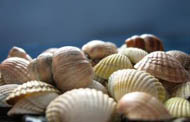
Purpose
To investigate the composition of a shell.
Additional information
Shells, along with eggs, snails, and other marine organisms, contain a chemical called calcium carbonate, a common substance found around the world. Common minerals and rocks where calcium carbonate exists is in chalk, limestone, marble, and travertine. It's also the active ingredient that causes hard water conditions in many households.
Seashells are the hard outer protective layer of marine organisms, animals without backbones commonly known as invertebrates. The shell is part of the body, in most cases the exoskeleton, which exists in order to protect the soft abdomens of the marine life that "wears" them. Shells are commonly found along shorelines and beaches when they are washed ashore by the tides. In most cases the shells are clean and emptied of the animal that once inhabited it.
Sponsored Links
Required materials
- Bowl
- Vinegar
- Several shells of varying size, shape, and color
- Hammer (or some other device for smashing)
- Safety Goggles
Estimated Experiment Time
Less than 5 minutes to set-up, about 72 hours to complete.
Step-By-Step Procedure
- 1. Place 1/2 of your shells in your bowl.
- 2. Pour some vinegar in the bowl. Pour enough so that your shells are completely submerged in the vinegar. You may need a bigger bowl if you can't submerge all of them.
- 3. Put the bowl in a safe place where it can remain undisturbed for at least 3 days.
- 4. After the 3rd day is up, drain the vinegar from the bowl and place the shells from the bowl on a flat, hard surface.
- 5. Place the shells that you had set aside from a few days earlier and place them next to the other shells (but make sure they're separated so you know which is which).
- 6. Put on your safety goggles.
- 7. Now, use your hammer to try to break the shells that were NOT submerged in vinegar. Note the difficulty in smashing them with the hammer.
- 8. Next use the hammer to smash the shells that were in the vinegar. Are they much easier to break?
Note
Always wear safety goggles when smashing things, especially shells! If you hit the shells too hard they may become projectiles, inflicting injury. The best method for smashing your shells is to hit them with the hammer at a controlled rate, preferably with taps until they break down.
Observation
What would happen if you let the shells soak for a few more days? How about weeks, or even months? Can you find out about anything else that is made from calcium carbonate?
Result
Shells are made up of a mineral called calcium carbonate. The vinegars effect on this mineral is to soften it, and eventually break it down. The longer the shells soak in the vinegar, the weaker the shells become! This is why the shells that were in the vinegar break very easily.
Sponsored Links
Take a moment to visit our table of Periodic Elements page where you can get an in-depth view of all the elements,
complete with the industry first side-by-side element comparisons!